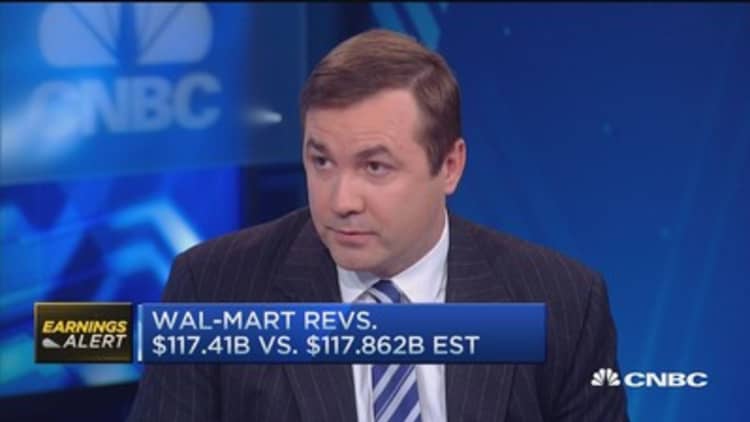


As the holidays near, investors face a crucial question: Do they believe last week's bad earnings news from retailers, or are they banking on the generally solid economic data that normally points to a stronger season and might have shown up in some stronger retail earnings reports on Tuesday morning?
That question has raced through Wall Street since last week, as retailers such as Nordstrom and Macy's missed third-quarter profit forecasts and, more importantly, trimmed guidance for the holiday season when retailers can make the lion's share of their annual profit. The fears abated slightly when Wal-Mart Stores announced third-quarter results on Tuesday morning that modestly missed forecasts, though the forecasts had been revised lower when the world's largest retailer cut its own forecast last month.
Investors have been hating on many retail stocks — the S&P retail sector was down close to 9 percent last week — but Wal-Mart, Home Depot and TJX Companies were all rising on Tuesday morning on upbeat results.
If low prices and the dollar are primary culprits in holding down reported numbers from retailers, does Tuesday's trading action suggest the beaten-up retail sector could be the biggest early discount of the holiday season?
Wal-Mart's report doesn't lay to rest questions about the holiday season, in which the National Retail Federation expects sales to rise by 3.7 percent from last year. Yet, considering that inflation is nearly nil, the industry-wide inflation-adjusted sales gain is expected to be larger than last year, according to economists at Wells Fargo.
The world's largest retailer said its third-quarter profit fell 11 percent to $3.3 billion, or $1.03 a share, as sales fell 1.3 percent to $117.4 billion but comparable-store U.S. sales rose 1.5 percent. Before the report, analysts had predicted profit of 98 cents a share on revenue of $117.8 billion. CEO Doug McMillon blamed the revenue drop on the impact of the strong dollar and said the company will boost annual revenue by $45 billion to $60 billion within three years.
"On a constant-currency basis, our total revenue would have been $122.4 billion," McMillon said. "That's growth of $3.4 billion, or 2.8 percent, on a constant-currency basis, which is solid growth. … I don't want the currency impacts to obscure the strength of our business. We are a growth company — and we're growing."
The hard part of figuring out what's happening is that all of these announcements came as consumer confidence surveys for November beat expectations handily, with University of Michigan researchers finding consumers feel better about their personal finances than they did last year and expect the past year's 25 percent drop in gasoline prices to keep holding inflation down. And they come shortly after third-quarter data on gross domestic product that continue to show consumer spending growing at more than 3 percent annually, adjusted for inflation.
"We're not economists; we're merchants," Nordstrom co-president Blake Nordstrom told analysts last week. "There are a number of economic indicators that look real positive for U.S. and the consumer and spending, yet all we can tell you is in our business we saw a slowdown."
Ever since Costco's Sept. 30 report on the last quarter of its fiscal year, retailers have been putting up below-par numbers. And even though Macy's disappointed last week, the biggest surprise was Nordstrom, a Wall Street darling for a strategy that balances full-price department stores, cut-rate Rack stores that provide about 30 percent of sales, and online operations that kick in another 20 percent.
Nordstrom controlled what it could control, but it still got hurt, with shares dropping 18 percent since its earnings and taking no part in Tuesday's retail bounce. The Seattle retailer's struggles also led Deutsche Bank to speculate that the economy is behind its troubles.
Retailers themselves mostly aren't emphasizing macro weakness, and like McMillon, retailers like Kohl's, J.C. Penney and Nordstrom say they're still confident about the strategies.
One factor in sales-and-earnings misses appears to be the weather, with warmer-than-normal temperatures keeping some people out of stores. That's what appears to have happened at Kohl's, where the average third-quarter shopper spent 1.8 percent more, but there were 0.8 percent fewer of them, the company said last week. Nordstrom said a drop in tourism to the U.S. by shoppers bringing goods back home shaved 1.5 percent off sales.
"I think the state of the consumer is reasonably OK," Macy's CEO Terry Lundgren said on a conference call. "Their savings accounts still indicate … that there is money to spend if the consumer chooses to do so in the fourth quarter. We're just waiting now to see if, in fact, they will."
"I have a feeling it's something more than the weather," KeyBanc Capital Markets analyst Ed Yruma said. But the data don't back up fears that retailers are looking at a slowdown akin to the 2008–09 recession or even weak seasons in 2001 and 2004. Yruma said his team had to go back to the 1990s to find weakness against a macro backdrop as strong as this year's.
Ready to spend
Indeed, economic data say U.S. consumers are confident and ready to spend. The macroeconomic details, especially very low inflation and outright deflation in many categories, seem to be the key pieces of the puzzle.
Third-quarter consumer spending rose 3.2 percent, with spending especially strong on durable goods, according to the Commerce Department. Consumer confidence is at Reagan-boom levels in some surveys, and Federal Reserve data show that revolving debt rose 6.5 percent in the third quarter, nearly twice the pace of expansion in the same part of last year, showing consumers are increasingly willing to borrow money to finance spending.
The only blot on the macro picture is the two most recent monthly reports on retail sales, each of which showed smaller-than-expected gains, but those can be mostly explained by deflation, economists say. At Costco, the stronger dollar and the lower price of gasoline combined to turn a 6 percent same-store sales increase into a 1 percent dip.
It's not just cheaper gasoline that is holding down reported retail sales, however. There's deflation in a series of goods-related categories, Regions Financial chief economist Richard Moody said. Prices for core goods have posted year-over-year declines for 30 straight months, he said.
"Goods deflation is largely ignored by those reacting to the retail sales data, but it does matter," Moody said.
Instead of blaming the economy, retailers have been telling investors they plan to roll up their sleeves and fix their own problems.
At Nordstrom, executives said they are continuing to invest in the business and still expect to reach $20 billion in annual sales by 2020, from a forecasted $14.6 billlion this year, driven by a big expansion of Nordstrom's Rack business and online channels. At Kohl's, a "soft macro backdrop" isn't curtailing expansions of the company's loyalty-marketing efforts and push to emphasize national brands like Nike, CEO Kevin Mansell said.
For investors, the impasse suggests that the selloff that followed last week's earnings reports will be temporary, possibly reversing itself if fourth-quarter profits meet revised forecasts. For consumers, a combination of goods deflation and the effects of retailers discounting clothing and other goods to work off inventories they built up earlier in the year could make for a nice holiday season indeed.
"We look for a 3.8 percent year-over-year increase," Moody said. "But weak pricing suggests this will feel much better for consumers than for merchants.''
— By Tim Mullaney, special to CNBC.com





